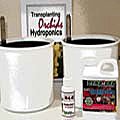After Repotting Phalaenopsis into Hydroponics - What to Look For
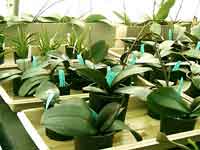 Phalaenopsis transplants in the greenhouse
Phalaenopsis transplants in the greenhousePhalaenopsis usually adapt to hydroponics without incident. Plants with healthy roots transfer easily. On the other hand, if your plant had damaged roots, a little "tender loving care" might be needed. More on that later ....
There are many varieties of phalaenopsis. Even though most of them transfer to hydroponics without incident, there are a two varietes that can present a challenge. They are:
Phalaenopsis with burgundy leaves. These plants do not like wet feet after repotting. Water new transplants by taking plant to the sink and just pouring water through the pebbles. Return plant to outer pot with no standing water at the base. Repeat 1-2 times a week.
Phalaenopsis with "Dorits" in the name (these plants can also have burgundy leaves). They also prefer dry conditions after repotting.
Plant Care After Repotting
If your plant had damaged roots, a little "tender loving care" might be needed. We'll show you what to do in the "Possible Trouble" section below.
Light
Give your plant bright light with a little morning or afternoon sun and let the Hydroponic System do the rest!
Water
Plants growing in hydroponics are very forgiving. Once your new transplant gets established in its new home, it will be stronger and more durable than before. But first, we need to develop an accurate rhythm for watering.
New roots need moisture - but did you know they also need air to grow? That's why it's important to wait for the system to dry out completely between waterings - so the roots get plenty of air.
Watering guidelines for new phalaenopsis transplants:
 Water new transplant to 1/4 - 1/2 on gauge Water new transplant to 1/4 - 1/2 on gauge |
 Wait until water gauge reads empty Wait until water gauge reads empty |
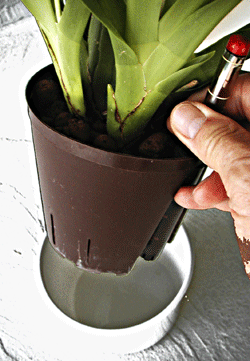 For the first couple of waterings, use the water gauge to lift plant and check bottom to make sure it's dry before rewatering For the first couple of waterings, use the water gauge to lift plant and check bottom to make sure it's dry before rewatering |
Orchids don't like wet feet! Waiting for the system to dry out completely before rewatering allows time for the roots to get the air they need to grow!
It usually takes a couple of days after the gauge reads empty for the system to dry out completely. Waiting might be difficult at first - so -use the water gauge as a handle and lift the inner pot to check for dryness. When the bottom of the pot is dry, go ahead and water again. This wet - dry cycle should take about 2 weeks.
Once your new transplant gets established - which usually takes about 4-6 weeks - you won't need to be as careful with your watering routine. Just remember to allow plenty of time for the system to dry out completely between waterings. You can even let your plant sit dry for several days.
Healthy transplants will use up all their water in two weeks - maybe sooner. Others may take longer a little longer. If your new transplant doesn't seem to be using any water after 2 weeks there may be problems, Dump out all the water and see the "Possible Trouble" section below.
What to Look for After Repotting
In most cases, newly transplanted Phalanopsis will adapt to our system without incident. Give your new transplant bright light with a touch of morning or afternoon sun and our hydroponic system will do the rest! Plants with healthy roots transfer easily.
As moisture is "pulled up" from the bottom by the LECA pebbles, fresh air circulates around the roots. The perfect environment for new root growth! In a few weeks, watch for new roots emerging at the base of the plant. Healthy new roots mean strong plants. And strong plants produce beautiful blooms.
In a few weeks, watch for new roots emerging at the base of the plant. Another sign to watch for is new growth at the center of the leaves. Healthy new growth is always good - even if some lower leaves are turning yellow.
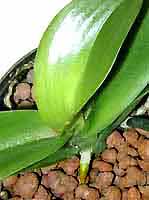 New roots on Phalaenopsis. Healthy roots are light grey with light green growing tip New roots on Phalaenopsis. Healthy roots are light grey with light green growing tip |
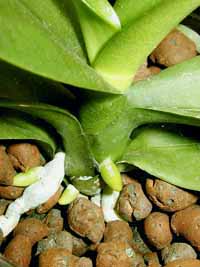 Don't worry if new roots are growing along the top of the pebbles - they'll find their way down. In fact, new roots are growing down inside the pot at the same time! Don't worry if new roots are growing along the top of the pebbles - they'll find their way down. In fact, new roots are growing down inside the pot at the same time! |
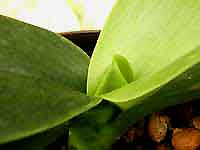 Another sign to look for is a new leaf emerging at the crown. Another sign to look for is a new leaf emerging at the crown. |
Don't get concerned if some of the older leaves turn yellow. One or two yellow leaves are normal. Remove discolored leaves so your new transplant will concentrate all its energy on new growth.
After Repotting - Possible Trouble
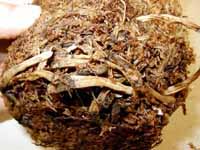 Decaying roots. Healthy roots are flesh colored and firm. Roots that are squishy or hollow are not active and should be removed.
Decaying roots. Healthy roots are flesh colored and firm. Roots that are squishy or hollow are not active and should be removed.If you found rotted and mushy roots when transplanting, your plant wasn't happy in its old pot. The roots where suffocating as the potting materials decomposed. You're new transplant is going to need some TLC and expect some wilted leaves at first.
If your new transplant has droopy or wilted leaves it's not happy. The roots aren't delivering the moisture up to the leaves and your plant is becoming dehydrated.
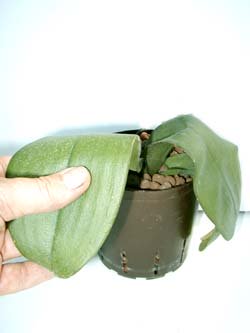 New transplant with droopy leaves. New transplant with droopy leaves. |
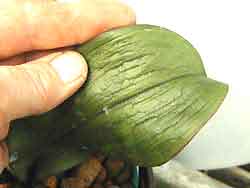 Dehydrated leaves - the roots aren't sending up moisture to the leaves. Dehydrated leaves - the roots aren't sending up moisture to the leaves. |
Wilting leaves! Your first instinct is more water .... or maybe an extra dose of nutirents!
Stop! That's exactly the wrong response!
The roots have shut down and can't absorb moisture. Inactive roots need more air, not more water. Struggling roots will suffocate with more water.
Idle roots can't absorb nutrients either. An extra dose of nutrients is dangerous because unused nutrients turn to salt - and salt will cause even more damage to the root system.
The correct approach is 1) use KLN Rooting Solution in place of nutrients and 2) change your watering routine.
1. KLN Rooting Solution
Mix KLN Rooting Solution 2-3 TBS per quart. KLN promotes new root growth while resisting disease. Regular fertilizer can actually be harmful at this point. Save whatever KLN solution you don't use in a cool dry place for future waterings .
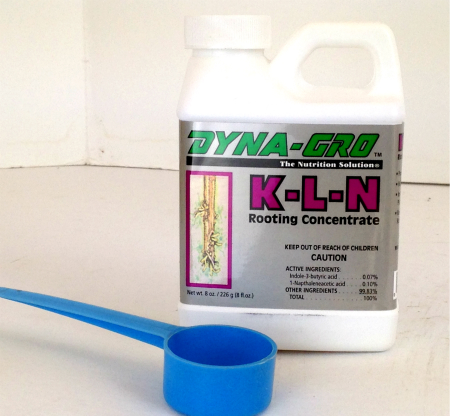 KLN Rooting Solution promotes new root growth.
KLN Rooting Solution promotes new root growth.
2. Changing Watering Routine
Cut back on water because new roots need air to breathe. That means no standing water is allowed at the base for now.
New watering routine:
- Use the water gauge as a handle and lift inner pot (with plant) and take them to the sink.
- Slowly pour KLN Solution through pebbles until it runs out the bottom of the pot.
- Return plant to outer pot - no standing water at the base.
Repeat this process 1-2 times per week. Continue for 4-6 weeks. Be on the lookout for 1) new roots growing at the base of the plant or 2) a new leaf sprouting out at the top of the plant.
If the problem persists, repotting (again) might be necessary. Gently remove the plant from its pot to see what's going on.
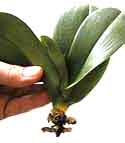 Trim away mushy roots (again). Your plant might even look like this when you're through. Trim away mushy roots (again). Your plant might even look like this when you're through. |
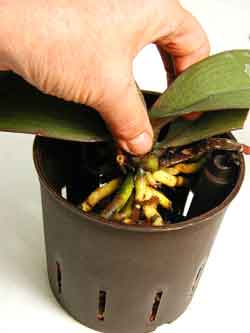 Fill bottom of culture pot with pebbles. Holding plant steady, add fresh pebbles. Fill bottom of culture pot with pebbles. Holding plant steady, add fresh pebbles. |
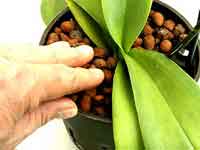 Pack down pebbles for stability Pack down pebbles for stability |
Repeat watering routine described above.
Struggling plants take 4-6 weeks to respond. Look for new roots sprouting at the base - or new growth at the top. When it looks like the plant is recovering, gradually return to a regular watering routine by watering to only 1/4 on gauge (or less). Then, make sure system is completely dry before rewatering.
If your plant doesn't use up all its water in 2 weeks, it's still struggling. Dump out whatever water is left in the pot and force a dry period of 1 week before rewatering.
If you don't see improvement, continue watering with the process described above until plant recovers ..... or until you decide to give up. Remember, there is a "Plant Heaven".
For more on Phalaenopsis:
Orchid Care with Hydroponics - Phalaenopsis
Repotting Phalaenopsis into Hydroponics


